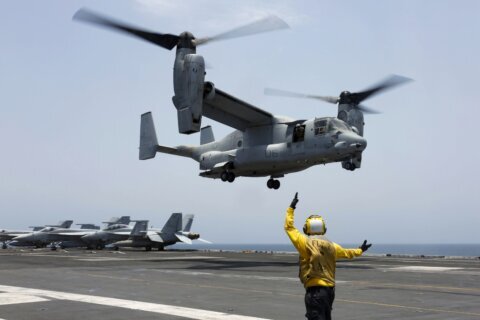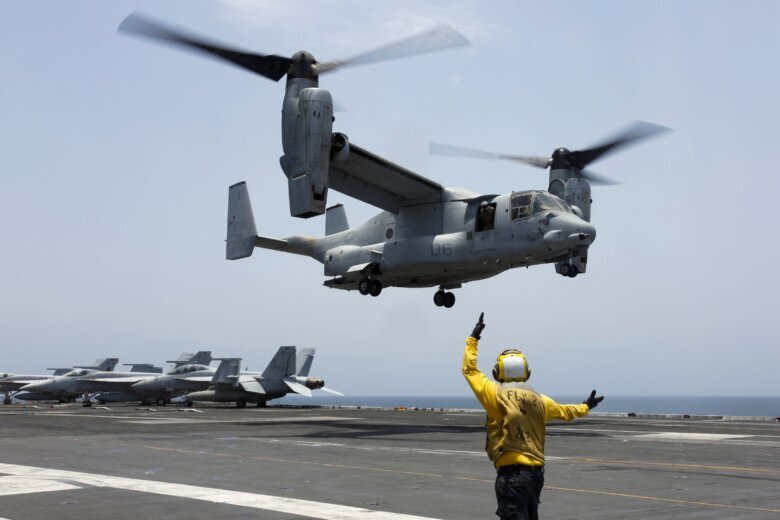
WASHINGTON (AP) — Air Force Special Operations Command said Tuesday it knows what failed on its CV-22B Osprey leading to a November crash in Japan that killed eight service members. But it still does not know why the failure happened.
Because of the crash, hundreds of Osprey aircraft across the Air Force, Marine Corps and Navy have been grounded since Dec. 6. There are two investigations that are looking into the Japan crash — a safety investigation board, which is a privileged internal review conducted in private to help inform pilots and crews, as well as an accident investigation board, which is the official administrative review. Both are still ongoing.
On Tuesday, Pentagon spokeswoman Sabrina Singh said her understanding is that “the Ospreys are not going back in the air at this time.” She said it will be up to the military services to determine when they will be safe to fly again, and she said she can’t say if that will be while the investigations continue or must wait until they are completed.
Separately, Air Force Special Operations Command is doing its own comprehensive review of its CV-22 Osprey program, and while the command has said it knows what failed, it has not made those details public.
“At this time, the material failure that occurred is known but the cause of the failure has not been determined. Engineering testing and analysis is ongoing to understand the cause of the material failure, a critical part of the investigation. Any disclosure of findings prior to investigations being finalized is premature and presumptive,” Air Force Special Operations Command said in a statement released Tuesday.
The Air Force, Navy and Marine Corps have been coordinating their efforts on when Osprey crews will be able to safely return to the skies. Each service will make its own determination, and the Air Force said to return its fleet of about 50 Ospreys to flight, “the priority is to inform our deliberate return to fly and ensure CV-22 aircrew and maintainers have the information they need to prevent future mishaps.”
The Osprey is a tiltrotor aircraft that can fly like both a helicopter and airplane.
Late Monday, NBC News reported that the crash was linked to chipping from the Osprey’s proprotor gearbox. When small pieces of metal chip off gears in the aircraft due to wear, it can generate dangerous metal debris that can damage engines. The gearbox has been under scrutiny in various Osprey accidents and some of its components have been wearing out quicker than expected. In January 2023 the Department of Defense awarded Bell-Boeing $12.7 million to improve the gearbox design across all of the Air Force, U.S. Marine Corps and Navy Osprey variants.
Air Force Special Operations Command was not available to comment on whether a gearbox chip caused the accident. However, it would not be the first time a chip issue was linked to an Air Force Special Operations Command Osprey mishap.
In July 2013, an Osprey experienced a proprotor gearbox chip inflight, the size of the debris required the entire gearbox to be replaced. In January 2014, an Osprey made a precautionary landing after another mid-flight gearbox chip, according to data obtained by The Associated Press.
Chipping can be caused by a variety of factors, including a lack of lubrication for the gears, or the gear teeth being subject to force overloads, said Rex Rivolo, a retired Air Force pilot who analyzed the Osprey for the Pentagon’s test and evaluation office from 1992 to 2007 as an analyst at the Institute for Defense Analyses.
The Osprey has a chip detector that triggers a warning to crews if metal fragments are detected, alerting them that there are pieces of metal breaking off the gears. “The procedure is to land immediately,” Rivolo said. “Most chip warning lights are due to very small pieces of metal and are harmless, and the aircraft lands safely.”
Copyright © 2025 The Associated Press. All rights reserved. This material may not be published, broadcast, written or redistributed.








